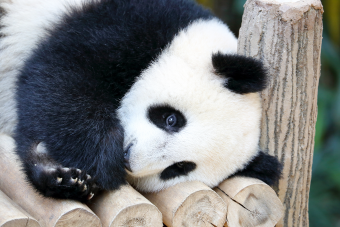Renting Pandas
 Whether in D.C., London, Adelaide or Madrid, nearly all giant pandas in today’s zoos are technically there on a 5 or 10-year loan from China, and at a substantial price.
Whether in D.C., London, Adelaide or Madrid, nearly all giant pandas in today’s zoos are technically there on a 5 or 10-year loan from China, and at a substantial price.
It hasn’t always been this way, though. Beginning in the late 1950s and through the early 1980s, the People’s Republic of China used the gift of a giant panda as a means of diplomacy; during those three decades, they gave over 23 pandas to nine countries including Great Britain, Japan, Spain, United States and Mexico.
Most of these gifted pandas have perished (in captivity, giant pandas have an approximate 30 year lifespan compared to about 20 years in the wild), although at Mexico City’s Chapultpec Zoo, two “grandfathered” pandas who are offspring of former gifted parents, Shaun Shuan and Xin Xin, remain. However, other than these two, it is difficult to find a giant panda that doesn’t belong to China.
Why? In the early 1980s, China changed its policy and decided to make a little money off of this one-of-kind creature that, up until recently, was really difficult to breed in captivity. Accordingly, today China charges around $500,000 to $1,000,000 per year for the loan of a giant panda, with, at least in the case of the United States rentals since 2011, a considerable amount of that money required to go to giant panda conservation efforts.
As for the offspring of rented pandas, according to the terms of the loans, any cubs born to rented-out giant pandas are China’s property and must be returned to the country after roughly two years; in addition, if a cub dies while on loan and it is deemed to be because of human error, a penalty in the hundreds of thousands of dollars range may also be assessed.
The Chinese government also requires a life insurance policy be taken out on each panda loaned out. In the United States, the contracted life insurance policy must be $1 million, set to be paid to the Chinese government should the panda die. In addition, according to the current U.S. contract, if the death is deemed to be from improper care or otherwise caretaker error, an additional $800,000 must be paid to China.
Beyond the cost of acquiring them, giant pandas are also expensive for zoos to maintain, as they require special housing and, of course, enormous amounts of fresh bamboo – with an adult eating up to 40 pounds of the fibrous plant each day. (Note: if the bamboo isn’t fresh enough, the pandas simply won’t eat it, requiring that it either be grown nearby or imported regularly.)
For reference on the total costs here, in the last two decades the San Diego Zoo claims, after all associated costs have been tallied, they’ve spent over $40 million on their giant panda exhibit. However, the president of Zoo Advisors, David Walsh, notes that “Yes, they are expensive to maintain and exhibit, but they are a tremendous draw. It does make economic sense, if you have the right market.”
For example, in the year 2000, the first year the Atlanta zoo had giant pandas, it broke attendance records, and after its first cub, Mei Lan, was born in 2007, it saw another attendance surge of 25%.
If you liked this article, you might also enjoy our new popular podcast, The BrainFood Show (iTunes, Spotify, Google Play Music, Feed), as well as:
- The Bear Who was Officially a Member of the Polish Army During WWII
- If You Own Land, How Far Above and Below Do You Own?
- That Time the Soviet Union Owned Tetris
- For the Last 1,000 Years, the Same Families Have Owned Most of England
- What’s Wrong with Giant Pandas?
Bonus Facts:
- Giant pandas’ only natural habitat is in bamboo forests in the mountainous regions of China’s Sichuan, Shaanxi and Gansu provinces. There are somewhere around 1,600 living in the wild and approximately 300 in captivity.
- Growing up to five feet in length, the largest giant pandas can weigh 300 pounds (about the size of a black bear).
- Pandas spend up to 12 hours a day eating bamboo, but also, at least in the wild, will eat rodents, insects, birds and fish.
- In the wild, giant pandas live alone and if they stumble on another, will engage in lame “fights” where they slap at, and occasionally bite, each other. Generally the only time they willingly get together is to make baby pandas, which gestate for between 100 and 180 days, and females produce only one or two cubs.
- Giant panda cubs continue to nurse for up to 18 months and aren’t considered mature until they are 4-5 years (for the females) and 6-8 years (for the males).
| Share the Knowledge! |
|




